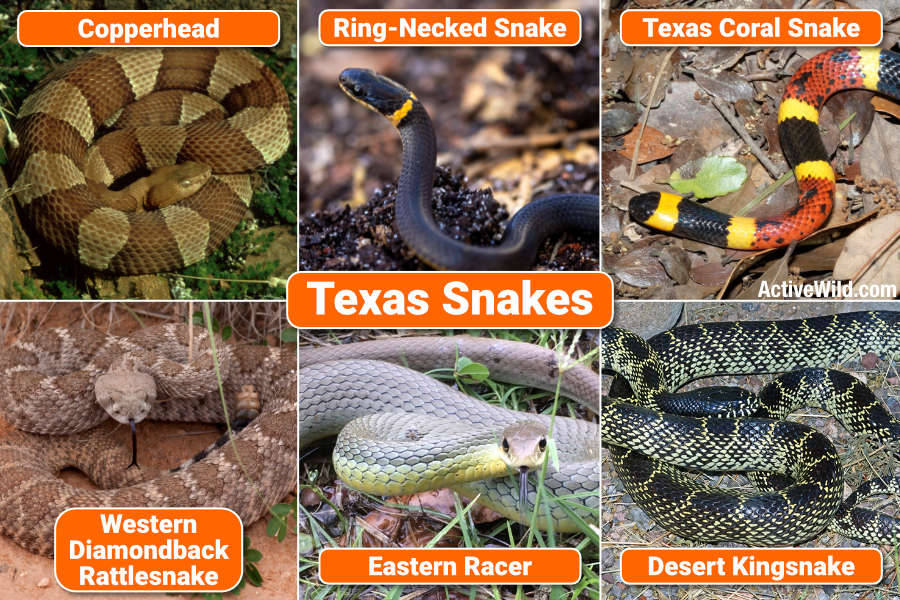List of Texas snakes, with pictures and facts. Guide to identifying snakes in Texas...
Introduction
Texas boasts a rich and diverse array of snake species, from the iconic rattlesnakes, typically found in deserts and grasslands, to the nonvenomous water snakes that inhabit the Lone Star State’s wetlands.
Snakes are fascinating animals that play an important part in the ecosystems of Texas, acting both as predators and prey. Although some snakes in Texas can be dangerous, most are harmless, and very few will attack unless they feel threatened.
If you encounter a snake, remain at a safe distance and do not attempt to touch or provoke the animal. Follow the tips further down the page when walking in areas known to be inhabited by snakes.
Texas Snakes Index
Snakes: Further Reading
- You can find out more about snakes on this page: Snake Facts
- Discover different types of snakes on this page: Types of Snakes
- You can find out more about reptiles on this page: Reptiles – The Ultimate Guide
- Discover different types of reptiles on this page: Types of Reptiles
Bullsnake
Scientific Name: Pituophis catenifer sayi
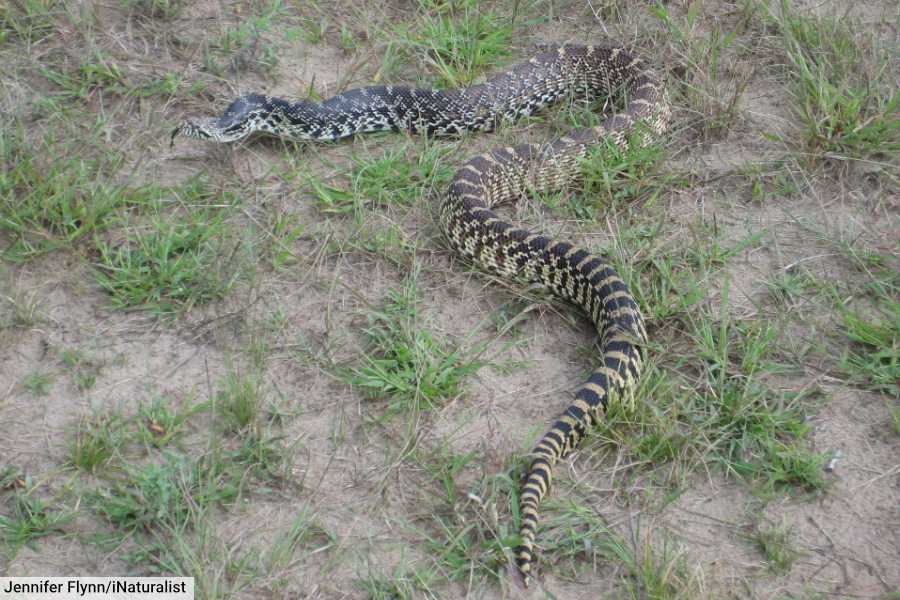
Family: Colubridae
The bullsnake is a large, nonvenomous snake that reaches up to 8 feet in length, making it not only one of the largest species within the Colubridae family, but also one of the largest snakes of North America. A subspecies of gopher snake, its coloration varies from yellow to brown with distinctive black, brown, or reddish blotching.
Native to central and southwestern USA, the bullsnake thrives in prairies, farmlands, and deserts, where it helps control rodent populations.
The bullsnake is known for its aggressive defense tactics, which include hissing loudly and vibrating its tail to mimic a rattlesnake.
Coachwhip

Scientific Name: Masticophis flagellum
Family: Colubridae
Coachwhips are slender, fast-moving snakes that can reach lengths of up to 8 feet. They are usually brown, black, or pink in color, and are named for their patterned scales, which resemble a braided whip.
The species inhabits various environments across the southern United States, including forests, prairies, and savannas. It is diurnal (active during the day), and hunts actively for lizards, small mammals, and birds.
The coachwhip is known for its distinctive behavior of “periscoping” (raising the head above ground level) to survey its surroundings.
Both the eastern coachwhip (Masticophis flagellum flagellum) and western coachwhip (Masticophis flagellum testaceus) subspecies are found in Texas.
Copperheads
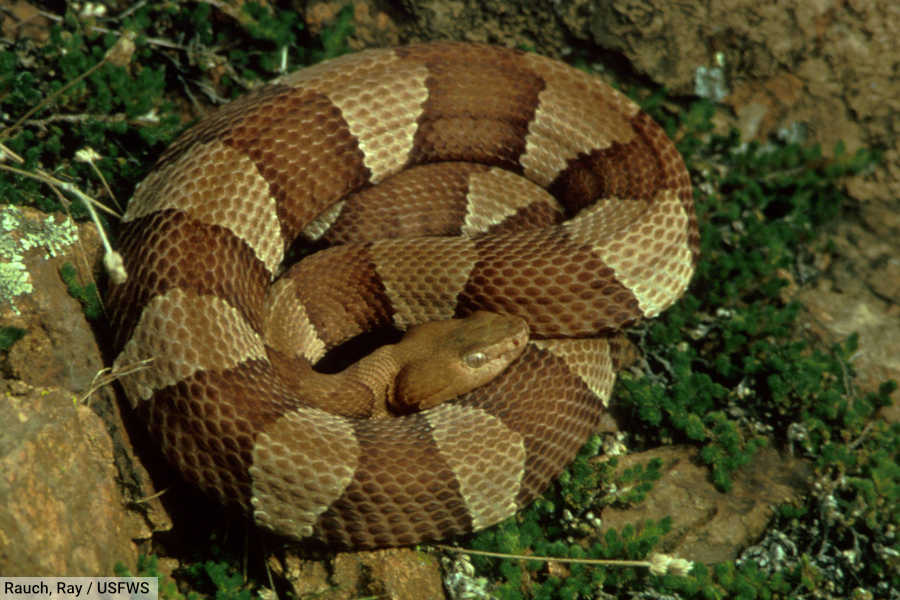
Scientific Name:
Family: Viperidae
Copperheads are medium-sized venomous snakes, usually not exceeding 3 feet in length. They have distinctive dark brown bands on a coppery-brown body.
There are two copperhead species: the broad-banded copperhead (Agkistrodon laticinctus) and eastern copperhead (Agkistrodon contortrix). Both species are found in Texas.
The bands of the broad-banded copperhead are more distinctly colored, less hourglass-shaped, and more straight-edged across the back than those of the eastern copperhead.
Copperheads are found in forests, rocky areas, and wetlands, their bands helping them to blend in with their surroundings.
Both species have a relatively mild venom and are generally not aggressive, tending to freeze when threatened. Their diet mainly includes small rodents, birds, and insects.
Copperheads belong to a larger group of snakes, the genus Agkistrodon, which also contains cottonmouths and other, related species.
Earth Snakes

Scientific Name: smooth earth snake: Virginia valeriae; rough earth snake: Virginia striatula
Family: Colubridae
The smooth earth snake is a small species, seldom reaching more than 10 inches in length. It has smooth scales with a brown or brown-gray coloration, often with a pink or reddish tinge, and small, faint dark spots.
The species prefers moist, forested areas with abundant leaf litter under which it can hide. It is secretive, nonvenomous, and primarily nocturnal, feeding on earthworms, slugs, and soft-bodied insects.
The rough earth snake is similar in size and appearance to the smooth earth snake, but can be distinguished by its keeled scales, which give the species a rough appearance.
Eastern Racer
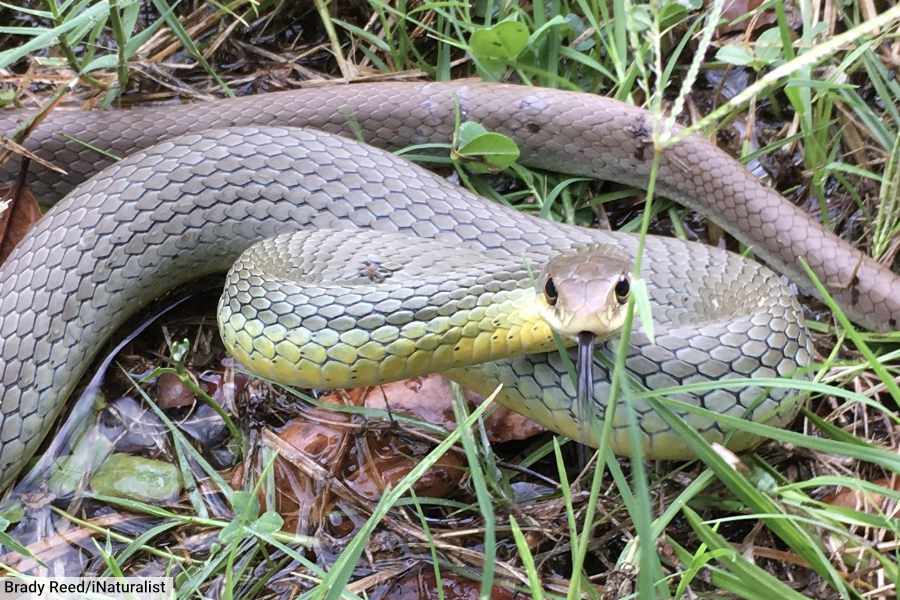
Scientific Name: Coluber constrictor
Family: Colubridae
The Eastern Racer is a slender, fast-moving, nonvenomous snake that can reach up to 5 feet in length. It has smooth scales and can vary in color from blue, green, brown, to black.
Racers are common throughout the eastern United States in habitats such as fields, farmlands, and open brush areas. They are diurnal, active hunters that feed on insects, rodents, birds, and other reptiles. Their speed and agility make them adept at escaping predators and catching quick prey.
The eastern racer snake has several subspecies. Subspecies found in Texas include: the buttermilk racer, tan racer and eastern yellowbelly racer.
Hognose Snakes

Scientific Name: (genus) Heterodon
Family: Colubridae
Hognose snakes are a group (the genus Heterodon) of snakes named for their characteristic upturned snouts (which resemble “hog noses”).
Hognose snakes typically range from 14 to 46 inches in length, and have various colors and patterns, including tan, brown, and olive with blotches or stripes.
Of the four hognose snake species, three are found in Texas: the Mexican hognose snake (H. kennerlyi); Western, or plains hognose snake (H. nasicus), and Eastern hognose snake (H. platirhinos).
Hognose snakes are known for their unique defensive behaviors, raising their heads off the ground, hissing, and expanding their necks like a cobra when threatened. If this display fails, they will play dead.
Hognose snakes feed mainly on amphibians, especially toads, and are resistance to the toxins that the amphibians secrete. The snakes are mildly venomous but generally harmless to humans.
Kingsnakes
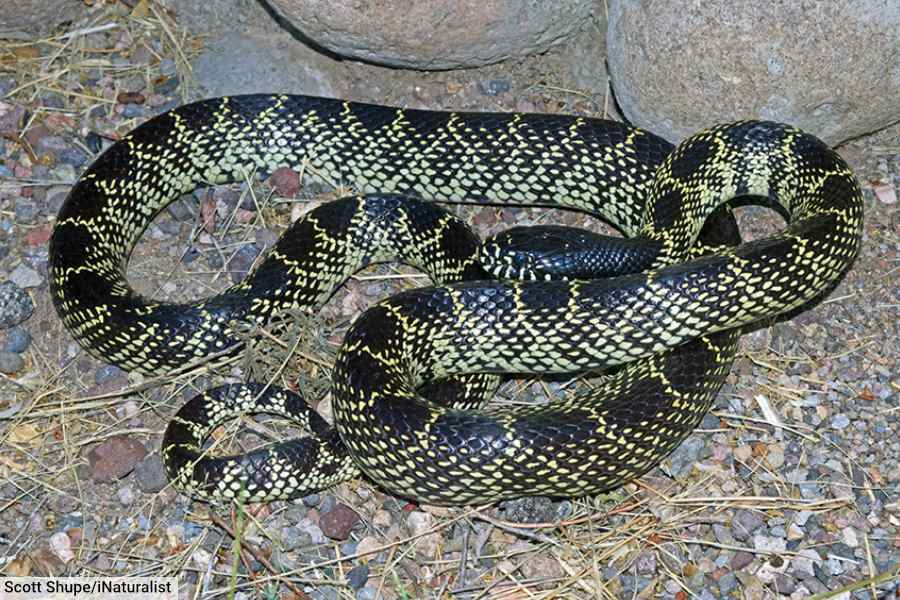
Scientific Name: Lampropeltis spp.
Family: Colubridae
Kingsnakes are medium-sized snakes, generally reaching lengths of between 3 to 5 feet. They have smooth scales, and exhibit a variety of color patterns depending on the species, often having bands, stripes, or speckles in different shades.
Kingsnakes are nonvenomous constrictors that specialize in hunting other snake species. Some kingsnakes are known to be immune to the venom of pit vipers, and prey on venomous snakes. They also eat rodents, birds, and eggs.
Kingsnake species found Texas include the desert kingsnake, prairie kingsnake and speckled kingsnake.
- The desert kingsnake typically has a black or dark brown body with light-colored bands or stripes running down its length, often resembling a chain-link pattern. It is found in a range of habitats (not just deserts, as its name suggests.)
- The prairie kingsnake has a similar appearance but is paler in color (light gray) with dark brown / orange blotches. It is often found in grassland habitats.
- The speckled kingsnake ranges in color from black to brown, and has white or cream-colored speckles or spots on its scales.
Long-Nosed Snake

Scientific Name: Rhinocheilus lecontei
Family: Colubridae
The long-nosed snake is distinguishable by its long, slightly upturned snout and distinctive banding. Typically growing up to 2.5 feet, it has a cream or light-colored body with black banding and red blotching.
Found in Texas and the southwestern United States, particularly in arid and semi-arid regions, the long-nosed snake often inhabits sandy areas and grasslands. The species is nocturnal, feeding on small rodents, lizards, and sometimes eggs.
The Long-Nosed Snake is nonvenomous and relatively docile, often burrowing into the sand to escape the heat of the day.
Milk Snake
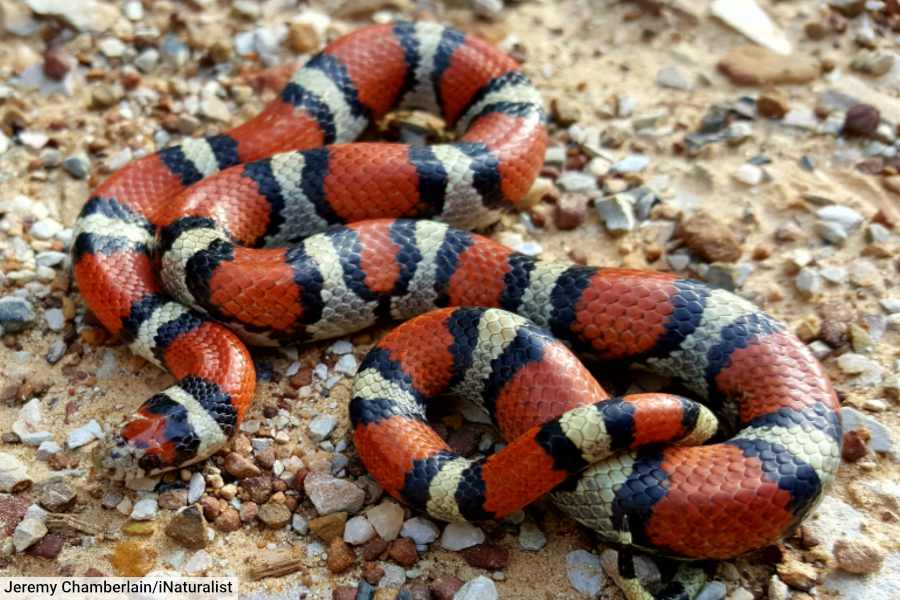
Scientific Name: Lampropeltis triangulum
Family: Colubridae
The milk snake / milksnake is a non-venomous species of snake found across North and Central America. Characterized by vibrant colors and distinct banding patterns, it typically ranges from 20 to 60 inches in length.
Currently, 24 subspecies of milk snake are recognized. Varieties found in Texas include the western milk snake, eastern milk snake, Louisiana milk snake and Mexican milk snake.
A milk snake’s smooth scales are marked by alternating bands of red, black, and yellow or white, resembling the venomous coral snake, which serves as a form of protective mimicry.
Milk snakes are adaptable and inhabit various environments, from forests to grasslands. They are nocturnal hunters, preying on small rodents, birds, and eggs. Due to their docile nature and striking appearance, they are popular among reptile enthusiasts.
Northern Cottonmouth / Water Moccasin
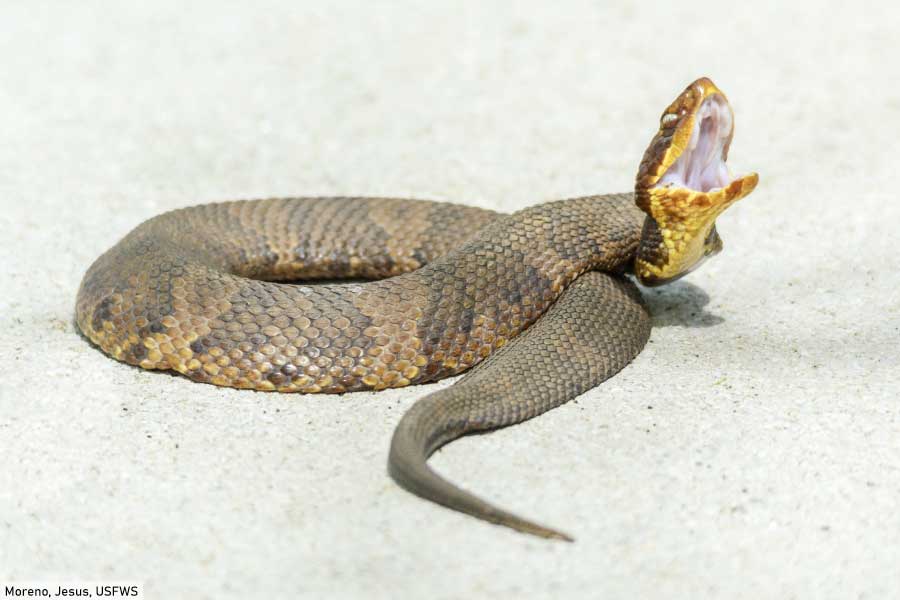
Scientific Name: Agkistrodon piscivorus
Family: Viperidae
The northern cottonmouth, also known as the water moccasin, is a venomous snake that can reach lengths of up to 4 feet. It is heavy-bodied with a distinctive dark, band-like pattern on a background that may be brown, olive, or black.
Like all pit vipers, the northern cottonmouth has a “sixth sense” in the form of a heat-sensing organ located in a pit between the eye and nostril on each side of the head. Other pit vipers include lanceheads and rattlesnakes.
The northern cottonmouth is a semi-aquatic snake found in Texas and the southeastern United States. It frequents swamps, ponds, and rivers.
The species is venomous and can be aggressive when threatened, coiling its body and displaying its fangs and the white inside of its mouth (hence the name, “cottonmouth”). It feeds mainly on fish and amphibians.
Rattlesnakes
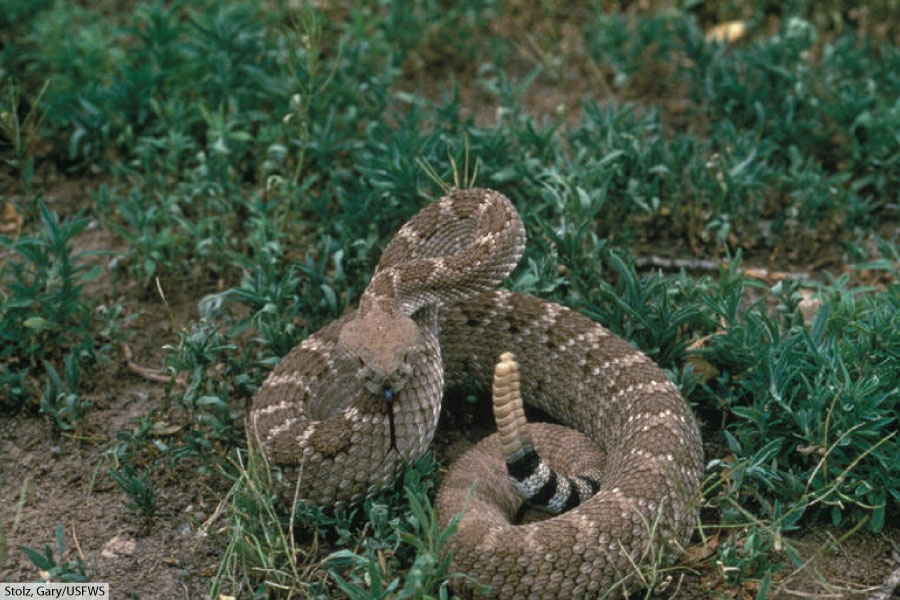
Scientific Name: Crotalus spp.
Family: Viperidae
Rattlesnakes are members of the pit viper subfamily Crotalinae identified by the presence of a rattle – a cluster of dried scales – at the end of the tail. When threatened, a rattlesnake vibrates its tail to produce its distinctive warning sound.
Like all vipers, rattlesnakes are venomous, and a bite from a rattlesnake is potentially fatal (although rarely-so if treated rapidly). Although rattlesnakes rarely attack unless provoked, extra care should be taken in areas in which rattlesnakes are known to reside.
Rattlesnakes vary in size, color, and pattern, but generally exhibit a series of dark bands or diamonds along the body. Native to the Americas, they occupy diverse habitats ranging from deserts to forests.
Rattlesnakes play a critical role in ecosystems as predators controlling rodent populations. Like all pit vipers, they have a heat-sensing pit organ that aids in detecting warm-blooded prey.
Thirty-six species of rattlesnakes are currently recognized, around ten of which are found in Texas. The most common rattlesnake in Texas is the western diamondback rattlesnake.
Examples of rattlesnakes found in Texas are listed below:
- Western diamondback rattlesnake
- Eastern diamondback rattlesnake
- Prairie rattlesnake
- Timber rattlesnake
- Desert massasauga
- Eastern massasauga
- Western massasauga
Ring-Necked Snake

Scientific Name: Diadophis punctatus
Family: Colubridae
The ring-necked snake is a small, slender, non-venomous snake species, typically around 10 to 15 inches long. It has a distinctive yellow or orange ring around its neck, along with a matching belly color, contrasting against its dark gray, blue-black, or brown back.
The species is widespread across North America, inhabiting forested, grassland, and desert environments. It is secretive and nocturnal, preying on small invertebrates like worms, slugs, and insects.
If threatened, the ring-necked snake will curl its tail to reveal its bright underside.
Texas Brown Snake

Scientific Name: Storeria dekayi texana
Family: Colubridae
The Texas brown snake is a subspecies of brown snake (a species also known as De Kay's brown snake) common in Texas and found as far north as Minnesota.
A small, nonvenomous species, the Texas brown snake rarely exceeding 15 inches in length. It has a brown or grayish background color with darker spots down the back and a lighter-colored belly.
The Texas brown snake inhabits wooded areas, meadows, and suburban yards. It is often found under rocks or logs, and feeds primarily on earthworms and soft-bodied insects. Its secretive nature and camouflage help it avoid predators.
Texas Coral Snake

Scientific Name: Micrurus tener
Family: Elapidae
The Texas coral snake can be identified by its bright coloration of black, yellow, and red bands. It is one of around 80 species of coral snakes found in North America.
The Texas coral snakes possess potent venom, and without prompt medical treatment, a bite from a coral snake can be life-threatening.
The mnemonic "red on black, a friend of Jack; red on yellow, kill a fellow" can be used to distinguish between the venomous coral snake and several non-venomous species with similar coloration (including the Texas scarlet snake and some kingsnake species).
The rhyme refers to the colored bands on the snake's body; on a coral snake, the red and yellow bands are touching; in non-venomous species, the red and black bands are touching.
(The rhyme is not always accurate and should not be relied on for exact identification.)
Although individuals are known to reach lengths of up to 4 feet, most are around half this size.
The Texas coral snake prefers wooded, sandy, or marshy areas, primarily within Texas and northeastern Mexico. It is shy and reclusive, often burrowing underground or hiding in leaf debris. It feeds mainly on other snakes and lizards.
Texas Garter Snake (Subspecies of Common Garter Snake)
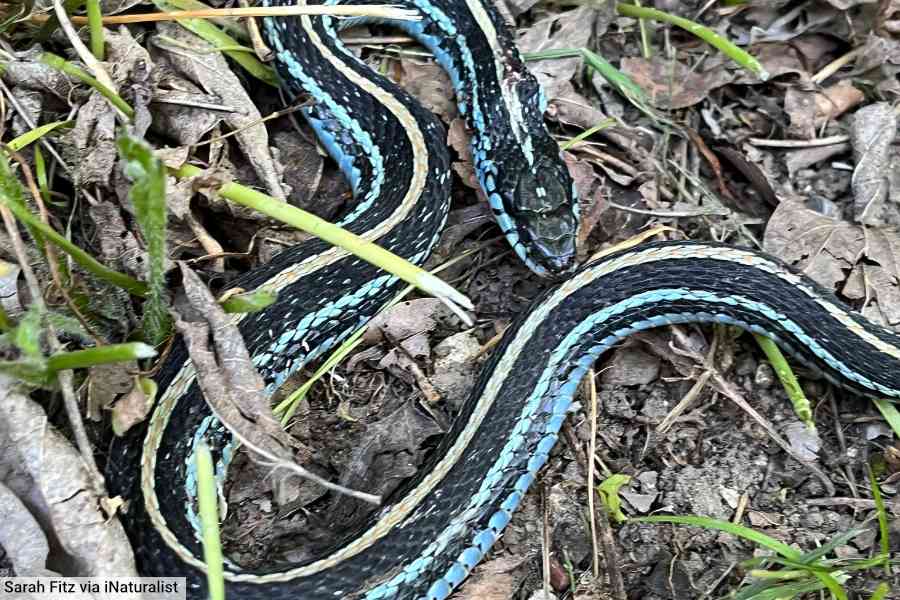
Scientific Name: Thamnophis sirtalis annectens
Family: Colubridae
The Texas garter snake is a subspecies of the common garter snake. It has an orange-red central stripe running along the length of its back, and paler stripes along its sides, together with other pale spots. It grows to about 18 to 26 inches in length.
The species inhabits a variety of environments, including marshes, streams, and woodlands across Texas. It is active primarily during the day and feeds on earthworms, amphibians, and sometimes fish.
Texas Glossy Snake
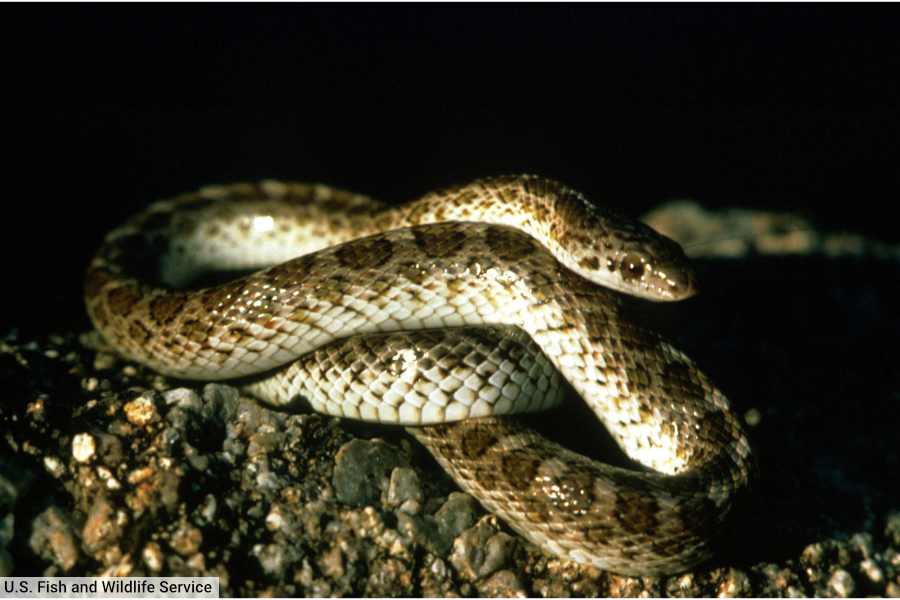
Scientific Name: Arizona elegans arenicola
Family: Colubridae
The Texas glossy snake, a Texas subspecies of Glossy Snake, is typically 2 to 4 feet in length and ranges from pale tan to light brown in color with darker brown blotches. Its smooth scales give it a shiny appearance.
This nonvenomous snake is found in the arid regions of the southwestern United States, where it burrows into loose sandy soils. It is nocturnal, emerging at night to feed on small rodents, lizards, and sometimes birds.
Texas Indigo Snake
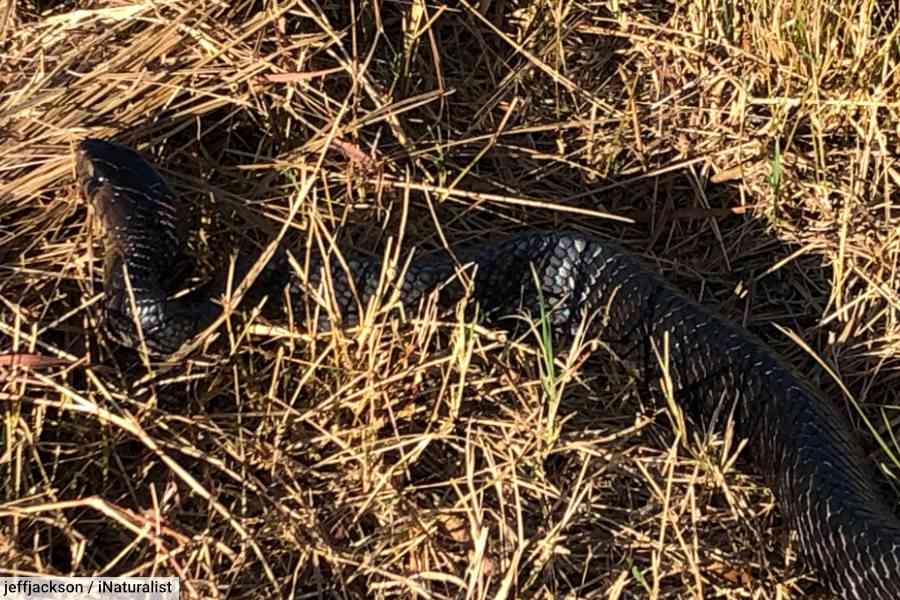
Scientific Name: Drymarchon melanurus erebennus
Family: Colubridae
The Texas indigo snake is a subspecies of indigo snake found in Texas and Mexico. One of the largest North American snakes, it is known to reach lengths of up to 8 feet.
This Texas snake has a uniform glossy blue-black coloration with some individuals displaying reddish-orange coloring around the chin, cheeks, and throat. Its undersides are pale with a pinkish hue. It is a nonvenomous diurnal predator that feeds on small mammals, birds, reptiles, and even other snakes, including rattlesnakes.
The Texas indigo snake inhabits a variety of terrestrial and semi-aquatic habitats.
Texas Lyre Snake
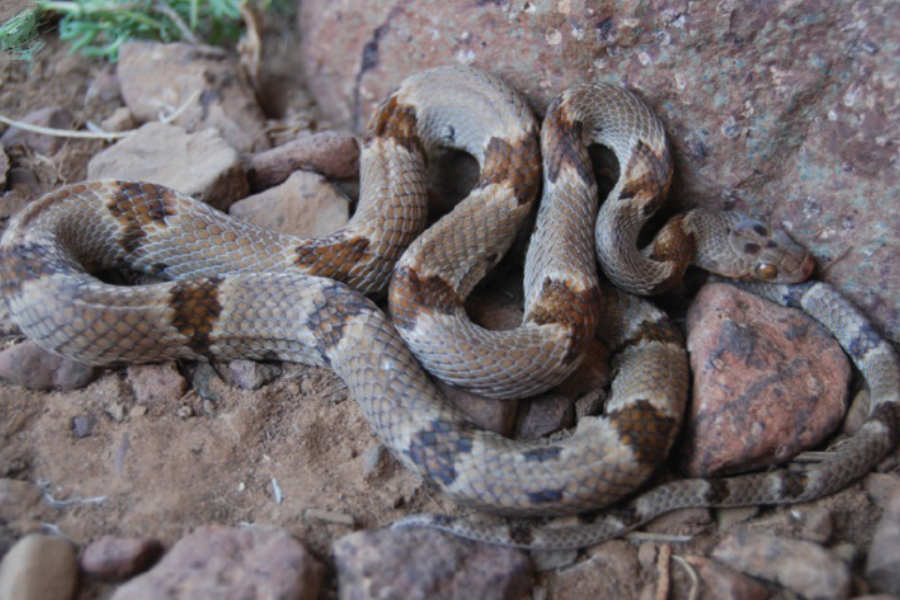
Scientific Name: Trimorphodon biscutatus lambda
Family: Colubridae
The Texas lyre snake is a medium-sized snake, generally reaching lengths of up to 3 feet. It has a pale gray or brown background color with darker brown or reddish blotches down the middle of the back that may form a lyre or 'V' shape.
Found in the southwestern United States and northern Mexico, the Texas lyre snake inhabits deserts and rocky terrain such as outcrops and cliffs.
This nocturnal species preys on lizards, small mammals, and birds. It is mildly venomous, although its bite is not considered dangerous to humans.
Texas Scarlet Snake

Scientific Name: Cemophora lineri
Family: Colubridae
The Texas scarlet snake is a small, burrowing snake that reaches lengths of about 14 to 25 inches. It has a distinctive tri-color pattern of red, black, and white or yellow bands. The species’ vivid coloration resembles that of a Texas coral snake.
The mnemonic "red on black, a friend of Jack; red on yellow, kill a fellow" can be used to distinguish between the nonvenomous Texas scarlet snake and the venomous Texas coral snake. (The rhyme, which isn’t always accurate, refers to the colors of the bands on the respective snakes’ bodies. On the venomous species, the red bands are next to the yellow bands.)
The Texas scarlet snake is found in the southeastern United States, particularly in Texas, within pine forests and sandy soils. It is nocturnal and preys primarily on other reptiles' eggs, such as lizards and snakes, using its pointed snout to excavate nests.
Water Snakes
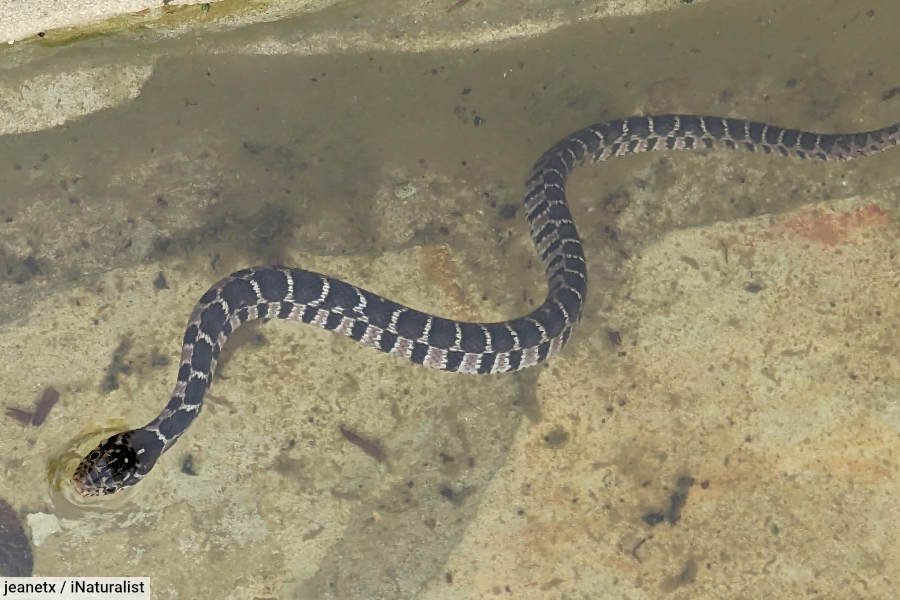
Scientific Name: Nerodia spp.
Family: Colubridae
Water snakes are a group (the genus Nerodia) of non-venomous and largely aquatic snakes found throughout North America. They are thick-bodied, medium to large snakes with flat heads, small eyes and keeled (ridged) scales.
Found near freshwater habitats such as lakes, rivers, and wetlands across North America, water snakes are proficient swimmers that feed primarily on fish and amphibians. When threatened, they can be aggressive and will bite, although they are generally harmless to humans.
Due to their size and preference for aquatic habitats, water snakes are often mistaken for venomous cottonmouths.
Several species of water snakes are found in Texas, including the plain-bellied water snake (Nerodia erythrogaster); diamond-backed water snake (Nerodia rhombifer); southern water snake / banded water snake (Nerodia fasciata); and green water snake (Nerodia cyclopion).
- The plain-bellied water snake can be identified by its lack of distinct markings and pale belly.
- The diamond-backed water snake has dark, vaguely diamond-shaped blotches along its olive-green back.
- The southern, or banded, water snake has wide, dark bands on a lighter background, although the markings are hard to discern on some darker individuals.
- The green water snake is identified by its greenish or olive-colored body.
Mud Snake
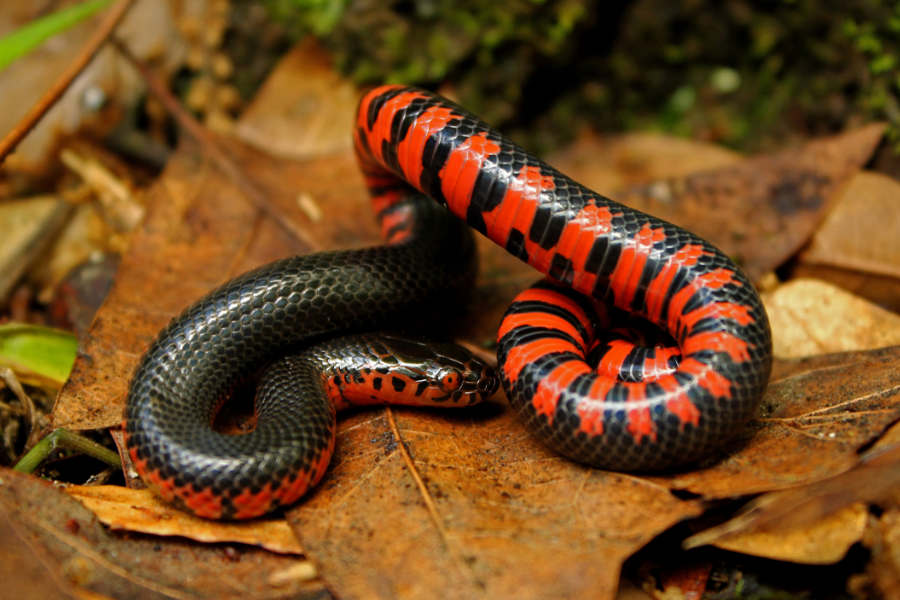
Scientific Name: Farancia abacura reinwardtii
Family: Colubridae
The western mud snake is a large species (typically 40 to 54 inches in length) recognized by its glossy, black scales and bright red or pink underside. It inhabits the southeastern United States, primarily dwelling in swamps, marshes, and the slow-moving streams of river floodplains.
This secretive, nocturnal snake is nonvenomous and preys on aquatic amphibians, especially sirens and amphiumas, which it swallows whole.
Western Rat Snake / Texas Rat Snake

Scientific Name: Pantherophis obsoletus lindheimeri
Family: Colubridae
The Texas rat snake is a subspecies of western rat snake found in Texas and surrounding states. It is a nonvenomous constrictor that grows to lengths of around 5 feet, and has a pattern of dark brown or black blotches on a lighter brown or gray background.
The Texas rat snake is found in various environments from wooded areas to rocky hills and agricultural fields. It preys on rodents and birds, climbing trees skillfully in pursuit of prey or to escape threats.
Western Ribbon Snake
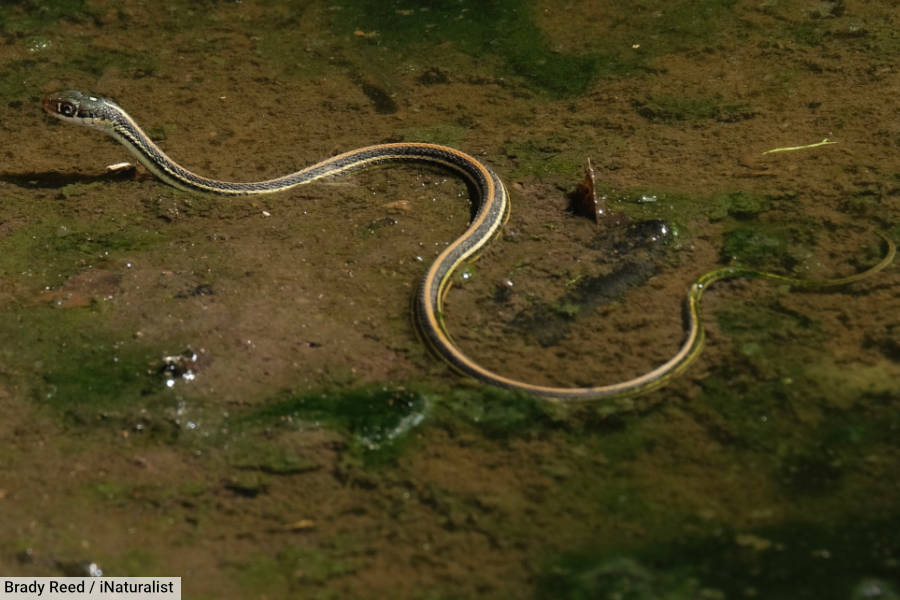
Scientific Name: Thamnophis proximus
Family: Colubridae
The western ribbon snake is a slender snake between 17 and 50 inches in length. It is typically black or dark brown with three bright yellow stripes running the length of its body.
Common in the central United States, the western ribbon snake favors habitats near water such as streams, ponds, and marshes. It is nonvenomous and active during the day, feeding on small fish and amphibians.
Tips For Staying Safe In Snake Areas
When walking in areas known for snakes, follow these safety precautions to minimize the chances of a negative snake encounter:
- Wear Protective Clothing: Use thick boots and long pants to shield against bites.
- Stick to Clear Paths: Avoid tall grass and underbrush where snakes may hide.
- Watch Your Step: Carefully look where you step or reach, especially near logs or rocks.
- Use a Stick: Tap ahead of you to alert snakes of your approach, giving them time to move away.
- Stay Calm: If you encounter a snake, remain calm and slowly back away; do not provoke it.
- Be Aware of Seasons: Snake activity can increase in warmer months.
- Learn About Local Snakes: Knowing which snakes are venomous can aid in emergency response if bitten.
Discover More About Snakes With Active Wild
You can find out more about snakes and related animals on the following pages:
You can find out more about snakes on this page: Snake Facts
Discover different types of snakes on this page: Types of Snakes
You can find out more about reptiles on this page: Reptiles – The Ultimate Guide
Discover different types of reptiles on this page: Types of Reptiles

